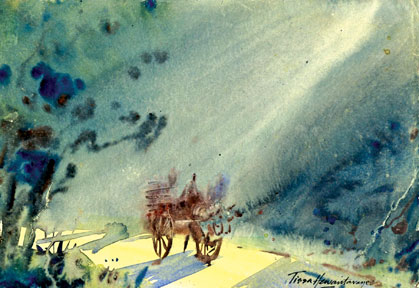The dark and light of values
by Tissa Hewavitarane
Most painters believe values to be the most important part of any
painting. No matter how beautiful the colours, how perfectly placed the
arrangement with thoughtful proportions, if the painting is weak in
values, it will be a mediocre or even a poor piece of work. The values
are the skeleton of the painting on which colour and form are added.
Without good values the painting collapses. Our world gives us many
nuances of values that they cannot be numbered. If our painting would
have all these values it would be a jumble. A limited scale value,
therefore, gives the painting strength and validity. Every subject and
every day gives us a different value range. This is why the artist must
have a very sensitive eye to observe these subtle value ranges.
It is also why it is bad to paint a scene too slowly because light is
always changing. The artist must grasp the light in the first half hour.
He should find the great ranges between the sky and the darks, the light
midtones to the light and the relationship to other midtones and to the
darks.
|

Misty morning |
It is of great importance how far is the light from the dark? After
that we can paint all day.
We must try to observe all the values nature gives us and group them
together in four or five large value masses. After that we can vary.
Importance
Always remember that the values are what make the painting's shapes.
The values are of great importance and one of the first things to be
considered. After we have the value, then we may add colour to it.
If you look at the natural landscapes, you will see hundreds of
values of dark and light, you cannot possibly paint them all, so do not
try to do so.
Instead, simplify by squinting your eyes, causing you to see only
large blocks of dark and light.
Generally, watercolourists start by putting down light values and
work through middle values to the darkest, simply because working over
previous areas makes them darker.
Value contrasts are one of the major factors in the sparkling quality
of watercolours.
The dark makes the light shine and the light makes the darks seem
deeper. Light values can be tied together in a painting and so can dark
values.
This can be accomplished by flowing unifying washes over certain
continuous dark shapes. This keeps the parts or the painting
decentralised.
The values in picture are said to be low in key. And the darks
usually create a brooding, sober and dramatic feeling just as would a
piece of music similarly full of deep notes. The effect on the viewer is
usually a happy one, just like the effect of a piece of music played in
the piano's bright upper register.
Variety
As we have seen, nature's colours are full of variety, but how can we
get the feeling into our paintings? It's only by working and
experimenting with colour in an effort to get a perfectly graded wash.
Anything to vary the wash and give it the look that an artist thinks
more accurately suggests colour, atmosphere and light.
Mae Bennet Brown, the fine painter of flowers, said, "lighter,
brighter, darker and duller." She meant that every time you do a wash,
you dull it. The white paper is the cleanest and brightest light of all.
The first wash sits on the surface of the paper and is very luminous. A
second wash, glazed over the first, naturally muddies and dulls the
colour. A third wash is duller still, and so on: lighter, brighter,
darker and duller.
Light is the life of the painting. And to guarantee bright, luminous
lights, the washes should be lively, bright, spontaneous and unworked,
lighter and brighter. It is also difficult technically to do everything
in one wash. You cannot control your edges. Working in a series of
washes also gives you better control of your colour.
Outdoors
Certain decisions have to be made even before you start to paint. For
example, what kind of day is it? Where is the sun? High or low? It is
going to be a rainy day? Each shift in position changes the character of
the subject. That's why watercolourists learn to work quickly outdoors.
The painting I have done titled "Misty morning" will show you the
values, the dark and the light and the approach to washes work.
The mist lends itself ideally for portrayal in watercolour. There can
be a few atmospheric effects which are fascinating and mysterious. The
mist has a distinct colour of its own which may be a cold grey or even
have a yellow tint. The local colours of individual objects will take on
some of this mist colour. For example, when the sun is struggling to
break through a morning mist everything in the picture is in various
tones of this golden colour.
Mist
Nearly all modelling is eliminated in the mist and you will mostly be
painting silhouettes, so the objects in your pictures should have
interesting contours retaining their crisp, sharply defined
outlines.Study the painting I have done.
I wanted to emphasise the mist. The sky was painted with a wash of
cobalt blue mixed with raw amber before it dried. Observe how the
sunlight falls to the ground.
One of the most attractive qualities about watercolour is the ability
to suggest even the transient effects of light, colour and atmosphere
found in nature. The picture is composed entirely of greys, ranging from
the palest tint to the deepest grey. |

